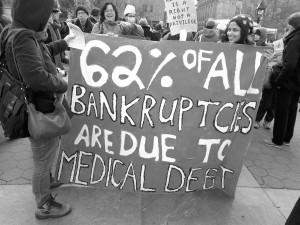Hospitals profit from exorbitant markups
22nd June 2015 · 0 Comments
By Jazelle Hunt
NNPA Washington Correspondent
WASHINGTON (NNPA) — Hundreds of American hospitals are turning a profit by charging patients exorbitant rates for necessary procedures. And for 50 hospitals in particular, the mark-ups are as high as 12 times the amount it costs them to deliver those services.
This is the revelation from a paper published last week in the Health Affairs medical journal, titled “Extreme Markup: The 50 U.S. Hospitals With The Highest Charge-To-Cost Ratios.”
“These 50 are outliers, they’re very skewed. But that does not mean all the other hospitals are hidden,” says Ge Bai, assistant professor of accounting at Washington and Lee University, and co-author of the paper. “It’s very difficult to tell [though]. You’d have to ask the question, when you walk in, at the front desk…about the ownership of the hospital.”
The researchers looked at 2012 hospital price lists for nearly 5,000 facilities across the country, and compared them to the Medicare-allowable costs, defined as the most reasonable fees a hospital can expect to spend in effectively delivering any given service to Medicare patients, as calculated by the government. They are not intended to guide hospital charges to patients, and every hospital creates its own price list. These lists are called chargemasters and are often difficult for patients to access and decipher unless a hospital takes the rare initiative to be transparent.
According to the study, most hospitals charge patients between 1.5 and four times the Medicare allowable cost. A smaller, but sizable number of facilities charge between four and nine times the cost. The 50 outliers — 49 of which were for-profit facilities — were charging patients between 9.2 and 12.6 times the cost they incurred in delivering services.
The top five hospitals with the steepest mark-ups, all charging at least 12 times the Medicare cost, were North Okaloosa Medical Center and Bayfront Health Brooksville in Florida; Carepoint Health-Bayonne Hospital in New Jersey; Paul B. Hall Regional Medical Center in Kentucky; and Chestnut Hill Hospital in Pennsylvania.
Florida is home to 20 of the 50 high mark-up hospitals identified in the study. The rest are spread across 12 other states — mostly in the South (76 percent are), and mostly in urban areas (84 percent are).
The other states were Alabama (which had five of these facilities), Arizona (one), Arkansas (one), California (three), Kentucky (one), New Jersey (one), Oklahoma (one), Pennsylvania (seven), South Carolina (one), Tennessee (three), Texas (five), and Virginia (one).
Two publicly-traded corporate hospital systems — Community Health Systems and Hospital Corporation of America — own 38 of these facilities.
Chargemasters vary widely, in general and within this top-50 group. For example, at Orange Park Medical Center in Florida (number eight on the list), if an uninsured person is admitted for one to two days for chest pain, he or she could be charged somewhere between $12,000 and $23,000. About 15 miles away at Memorial Hospital of Jacksonville, the same patient would be charged between $9,000 and $17,000, and that’s with an extra day of care. Both hospitals are owned by the same company, which voluntarily provides its price estimates.
Uninsured people feel the full force of these charges. While the Affordable Care Act has helped millions get coverage, the Centers for Disease Control and Prevention (CDC) estimates that 13.7 percent of Black people are still uninsured as of 2014 and will likely remain so. Many are low-income or below the poverty line, living in states that did not expand Medicare coverage. Half of the states housing the top-50 high mark-up hospitals did not expand Medicare.
Insured people who are “out-of-network” at these facilities are also vulnerable. Insurance companies do not set their terms based on the hospital’s prices — if a policy covers 70 percent of all emergency visits, then the patient is responsible for the 30 percent, whether the hospital charged $100 or $1,000. When a person gets a bill from a hospital that isn’t partnered with his or her insurance company, the company often pays little to nothing of that bill.
People who are both insured and in-network end up paying higher premiums when a hospital with high mark-ups is part of their network. As insurance companies have to cover members who end up in these for-profit facilities, they spread the steep charges among all their members.
“We don’t have price regulations in other industries so people can do comparative shopping. But in the health care market it’s very different. In many cases, we as consumers do not have the time…to compare prices,” Bai says, adding that during treatment, physicians don’t know or are not at liberty to discuss the hospital’s pricing systems. “We as consumers have no options before the service is provided. We just wait there hopelessly…we’re sick and anxious.”
About 30 percent of the hospitals sampled in the study were considered for-profit — Bai says that about half of all hospitals in the country are.
Maryland and West Virginia are the only states with complete health care pricing regulations. California and New Jersey have regulations for what hospitals can charge uninsured patients. Maryland’s system is widely considered a national model, with the lowest mark-ups in the nation (1.5 of Medicare allowable cost). The report recommends a federal system patterned after it.
“We knew these high mark-ups have been going on for a while, at least 15 or 20 years, but this is really over the top,” Bai says. “I think the public needs to understand…there’s a loophole in our system. The market has stopped working. That’s why we need the government to step to help regulate some of these prices.”
This article originally published in the June 22, 2015 print edition of The Louisiana Weekly newspaper.




